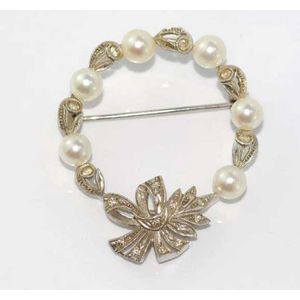Georgian Garnet Pendant in Silver Gilt - 2g, 17mm
You must be a subscriber, and be logged in to view price and dealer details.
Subscribe Now to view actual auction price for this item
When you subscribe, you have the option of setting the currency in which to display prices to $Au, $US, $NZ or Stg.
- Garnet - A garnet is a mineral that is commonly used as a gemstone. It occurs in a wide range of colours, including red, pink, orange, green, yellow, and black. The most common and best known type of garnet is the red variety, which has a deep, rich colour and is often referred to as a "garnet red."
Garnets have a long history of use as gemstones, and they have been prized for their beauty and durability for thousands of years. They are often used in jewellery, such as rings, necklaces, and earrings, and they are also sometimes used as a decorative element in other items, such as vases and goblets.
Garnets are prized for their brilliance, durability, and resistance to scratching, making them a popular choice for use in jewellery. They are also valued for their hardness, which makes them well suited for use in abrasive applications, such as sandpaper and grinding wheels. - Georgian - As an English stylistic period, Georgian is usually taken to cover the period from George I (1714) to the Regency of Prince George (1811-20), although the period from 1800 to 1830 is sometimes designated as the Regency period. During the Georgian period the great English cabinetmakers and designers such as Chippendale, Hepplewhite, Adam Sheraton etc., were all active.
Therefore there isn't a single 'Georgian style' as such and to say something is 'Georgian', usually means it was made between 1714 and 1830. This assumes we discount George V and George VI, both being from the 20th century.
The styles popular at the time of each reign were:
George I (1714-1727) saw out the last years of the Baroque period.
George II (1727-1760) reigned during the Rococo period.
George III (1760-1820) saw the last gasp of the Rococo, all of the early Neo-Classic 'Adam style' and most of the later neo-Classic 'Regency style'.
George IV (Prince Regent 1820-1830)encompassed the last of the 'Regency' style.
William IV's reign (1830-1837) was something of a no man's land (stylistically) and he wasn't a 'George' anyway. He covered the last glimmerings of 'Regency' and the start of the 'Victorian' style.
This item has been included into following indexes:
-
lockets
- garnet 103
- silver items 2,428
- pendants and lockets, set with - garnet 103
- pendants and lockets, silver - silver items 2,428
Visually similar items

A signed modern Korean ceramic vase, circa 1970, the ovoid vase with a petite neck and a flattened rim, with an overall iron brown mottled glaze with a encircling and trailing 'Crazy paving' motif; character marks underside. Height 29.5 cm

An amethyst, emerald and onyx ring, the fancy octagonal cut amethyst of 18.70cts, having emerald and onyx geometric detail to the shoulders, mounted in 14ct gold, ring size P

Superb F. Ebner American percussion plains rifle circa 1855-60. Half stocked in finely figured tiger maple with crescent brass butt plate and trigger guard, inlaid with silver stag, heart, star, etc. Approx 124 cm overall with 84 cm very heavy octagonal ba

Vintage 18ct white gold, pearl & diamond brooch, total weight approx 6.85 grams, size: approx 3 by 3.75 cm
